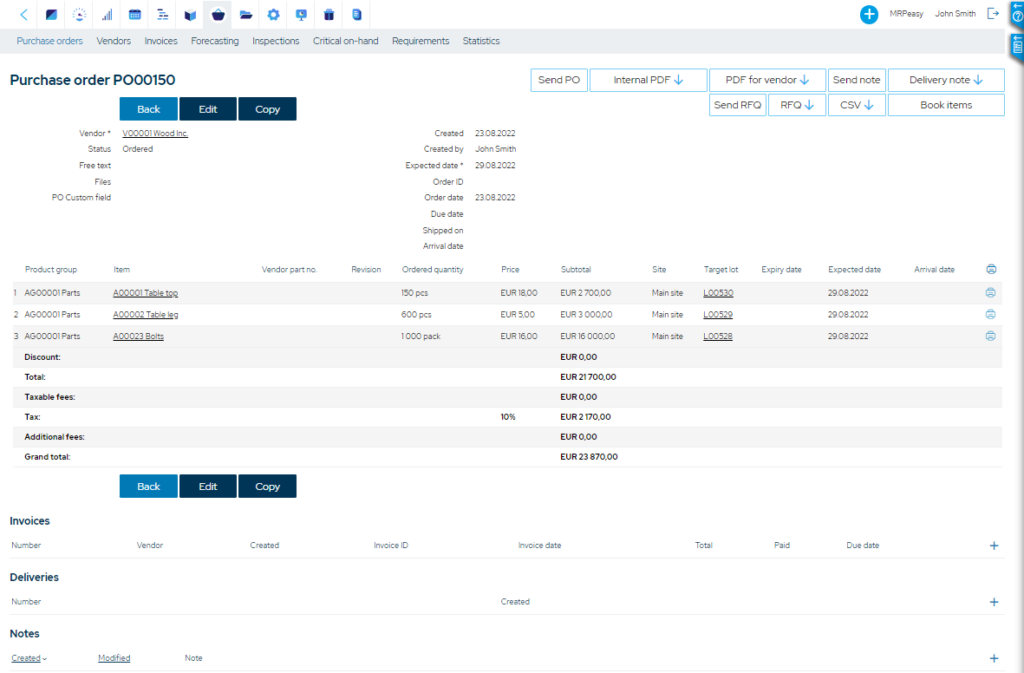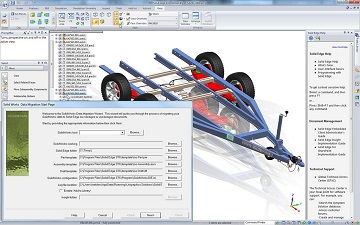Purchase Order Management – Achieving Consistent Deliveries
For any manufacturing company that relies on components and raw materials from suppliers, purchase order management constitutes an important set of practices that can significantly simplify the procurement process. In this article, we look at how to achieve consistent success with your procurements using the best purchase order management practices and solutions.

You can also listen to this article:
What is Purchase Order Management?
Purchase order management is the process of establishing and adhering to in-house standards and operating procedures for how a company handles its purchase orders. The aim of purchase order management is to make sure that purchase orders (POs) are issued, tracked, managed, and processed in an optimal and consistent way.
In order to maximize the efficiency of manufacturing process flows, components and parts need to arrive on time and in the right quantities. To ensure this, a company’s procurements – what to purchase, when, from who, at what cost, etc., must be planned ahead diligently. This strategic process is called procurement planning and is the chief task of the procurement department. Purchase order management is a subset of the larger procurement planning process that deals with issuing and handling purchase orders.
Since all direct procurements – any external items that a company relies on for creating goods – constitute inventory, both procurement planning, as well as the practical aspects of managing purchase orders fall under the domain of inventory management. While theoretically possible to handle with a pen and paper, most modern manufacturing companies employ dedicated inventory management and procurement software to ensure consistency and avoid errors.
The basics of Purchase Order Management
Purchase orders are in-house documents issued to confirm the intention of purchasing specific goods from external suppliers (vendors). POs will always include information on the type, quantity, and price of goods to be purchased. Depending on the level of sophistication of the purchasing solution, they may also include data on expected arrival time, payment and delivery status, additional fees and taxes, frequency of recurrence, etc. In most cases, a purchasing manager will first send out a Request for Quotation (RFQ) to one or more vendors and then issue a PO upon receipt of a suitable quotation.
In order to ensure that POs align with the company’s procurement plan, budget, production schedules, etc., companies employ purchase order management procedures. PO management process flows may be very different from company to company. There are a few common steps that the process usually revolves around, however. These include:
- Issuing, approving, and dispatching the Purchase Order. When items are needed for production, an internal purchase requisition stage will usually determine the issuing of a PO. After requisition, the PO may also need to pass an approval or review stage wherein it is sent to relevant departments and aligned with company policy. Once these internal qualifying procedures are complete, the PO is sent to a predetermined vendor, often selected from a qualified vendors list.
- Negotiation and acceptance. Upon receiving the PO, vendors will check if they can meet the item quantity, price, delivery time, and other requirements set by the PO, or whether there is a need to negotiate terms with the buyer. When the requirements or changes are accepted by both parties, the PO is accepted by the vendor and becomes a legally binding document.
- Delivery and tracking. Next, the required goods are manufactured or designated for delivery. Depending on agreements and the supply chain, the buyer is usually given constant access to information pertaining to the status and location of the shipment, i.e., order tracking.
- Invoicing. As the goods are produced or made ready for delivery, the vendor issues an invoice to the buyer for the purchased goods or services. Whereas the goods technically switch ownership only upon being paid for, they may often be booked into the buyer’s upcoming work orders while still in possession of the vendor or in transit. Production and supply chain management software can go a long way in streamlining manufacturing process flows and making use of pipeline inventory in this manner.
- Matching and payment. For reasons of quality assurance and often as part of company policy, the delivered goods are finally checked for conformity and a goods received note is issued, before the invoice is sent to the buyer’s accounts payable department. Once the payment is complete, the PO is archived.
Purchase Order Management best practices
As stated above, the purchase order management process may significantly vary between companies, depending on company structure, size, number of employees or manufacturing facilities, etc. For example, the requisition or approval phase may be limited in scope for smaller businesses. POs may also be recurring, depending on the type of goods manufactured or supply chain conditions. Responsibility for managing POs may be divided between project managers and shop-floor workers, or be the responsibility of the procurement officer or department.
Next, let us take a look at three purchase order management best practices we think will prove most helpful in setting up an optimal PO management process.
Automation
By far the most rewarding step toward increasing the efficiency of a company’s PO management process is to increase the proportion of automated steps. In most cases, the way to achieve this is by implementing a procurement software solution. This can constitute separate procurement software or an add-on integration with your existing MRP/ERP system.
Automation can simplify and streamline many key aspects of the PO process. A well-implemented procurement solution can essentially eliminate rogue spending. This is because every action is logged, increasing transparency throughout the organization. With more visibility over procurement data coupled with built-in tools for analysis, financial planning is much better informed. Software also helps reduce errors arising from manual data entry, consolidates the paper trail, and perhaps most importantly – saves time.
Clear guidelines
Managing and issuing purchase orders can be the responsibility of different people within a company depending on its size and structure. Setting clear guidelines for POs can help to make sure that whoever is assigned responsibility for managing them consistently follows the same procedures. This is especially useful in cases where there are more than one person authorized to issue POs.
Clear instructions should be put in place as to who can issue POs and when, what the approval workflow is like, who is responsible for the review process, etc. For companies with diversified product lines requiring components in very different quantities and prices, it is also a good idea to set per-price distinctions. For example, a PO with a total price below a certain threshold might have very limited approval requirements, while higher-priced components necessitate a C-level executive to chime in.
Streamlined review process
Errors may happen on both sides and in any step of the PO process, regardless of well-implemented procurement guidelines or seemingly bullet-proof software solutions. Oversights in delivery times, amounts of goods, prices, etc., can bring both financial as well as legal ramifications, not to mention hits to the company’s reputation. A consistent and comprehensive review process should thus be in place for any PO-related procedures.
Reviewing should include a clear list of priorities to check. These might include making sure that the vendor contact information is up to date, delivery dates and shipping methods are confirmed, prices or additional fees are double-checked and aligned with budget requirements, etc., before committal.
Choosing the right Purchase Order Management Software

Many starting businesses have limited production capacities and product lineups. As such, procurement may be relatively easy to manage with spreadsheets or an e-mail-based approach. As the manufacturing operation scales and the supply chain grows in complexity, bills of materials and their corresponding component requirements often become much more complex. This can make procurement management very complicated without a proper software solution.
Procurement software can come as a stand-alone solution or be offered as a module in more comprehensive ERP/MRP systems. In either case, purchase order management tools are a staple of procurement software and in most cases do not need to be acquired separately. To ensure seamless data flow and eliminate data duplication efforts, it is important that the chosen solution integrates well with the rest of the business management ecosystem. After all, procurement touches on many aspects of a business such as inventory management, production planning and scheduling, accounting, etc.
Standalone procurement software might be sufficient in many use-cases but it can seldom offer the level of business integration comparable with all-inclusive manufacturing ERPs. While these can be a lot more expensive, a host of SME-oriented software providers have sprung up in recent years, offering affordable solutions to companies of any size. For example, MRPeasy’s procurement software section includes a host of functions to easily manage all aspects of a company’s purchases including powerful built-in purchase order management tools.
MRPeasy allows managing procured items, purchase terms, vendors, and order statuses all in one place while being fully integrated with manufacturing. POs can be created in a breeze or compiled automatically. Parts and materials can be automatically booked into upcoming work orders when POs are confirmed. The critical on-hand report automatically highlights all items below minimum stock values. MRPeasy also includes automatic estimates for product costing and lead time calculations, automatically composed procurement forecasts based on sales data, automatic RFQ to PO conversion, and a host of other functions.
Key takeaways
- Purchase order management is the process of establishing and adhering to in-house standards and operating procedures for how a company handles its purchase orders.
- Most modern manufacturing companies employ dedicated inventory management and procurement software to handle purchase orders.
- Essential purchase order management processes include issuing, approval, negotiation, dispatch, delivery, invoicing, and matching.
- 3 purchase order management best practices are increasing automation, setting clear guidelines, and developing a bulletproof review process.
- There are a wealth of both standalone as well as integrated procurement management solutions to choose from.
- Manufacturing ERPs with built-in procurement tools are usually better integrated with production management and the larger business ecosystem.
You may also like: Vendor Management – An Essential Guide for SMEs



